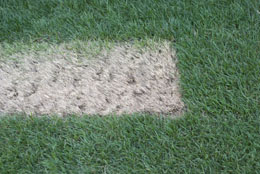Turf grass lawns are prone to various diseases like brown patch, dollar spot, and foliar blight and basal spot. These diseases can be effectively controlled by practicing cultural and chemical methods.

A turf grass lawn appears lustrous green and beautiful, as long as it is healthy and disease free. Nevertheless, like any other plant, turf grasses are susceptible to various plant pathogens, especially fungi. Very often, pathogens are present in a dormant state. They become active when favorable environmental conditions and susceptible grasses are present at the same time.
Diseases
One of the basic thumb rules to prevent turf grass diseases, is proper maintenance of the turf with appropriate watering, aeration, fertilization, and regular mowing. A slight alteration in the requirements makes them more susceptible to several pathogens. In majority of the cases, outbreaks are most common in extreme environmental conditions like drought, excess moisture, and very cold or hot temperatures.
Brown Patch
Brown patch is a common turf grass disease, which is observed during the summer months when there is high temperature and excess humidity. The occurrence of this disease is more in lawns that are maintained with high nitrogen fertilization. The causal organism for this disease is
Rhizoctonia solani. Like other ones, this fungus attacks the leaves and stem of the turf.
Identification and Control
If circular brown patches have developed in the lawn, then it is brown patch. A characteristic feature of the patches is the presence of a darker ring in the periphery of the patches. At times, the diameter of the circular patch exceeds more than a feet. The turf within the patch is thinned or killed completely.
Removal of accumulated dew on the turf grasses, helps in controlling further spread of the brown patch disease. Another tip for the management of this fungal disease is to reduce the amount of nitrogen fertilizers added in the lawn. In addition, fungicidal sprays are recommended immediately after the onset of the signs.
Foliar Blight and Basal Rot
Both foliar blight and basal rot of bluegrasses are caused by anthracnose (scientific name,
Colletotrichum graminicola). This fungal pathogen attacks, particularly, the foliage and stem of most turfgrass species. The early sign of this is the appearance of yellow or red lesions on older leaves. As the disease progresses, the pathogens further attack the young leaves and stems as well.
Identification and Control
Foliar blight and basal rot can be identified, if irregular yellow or brown patches are present in the lawn. This disease is most commonly observed in extreme cold and hot temperature conditions. On peer observation, the fruiting bodies of the fungus can be seen from the diseased foliage and stems of the grass, with the help of a magnifying lens.
Foliar blight and basal rot can be controlled effectively, if identified in its early stages. Cultural lawn care, like proper irrigation, fertilization, and good soil, helps in managing foliar blight and basal rot disease. Apart from this cultural control method, there are fungicidal sprays for killing the pathogens and/or preventing further spread.
Dollar Spot
Dollar spot disease is caused due to the fungus
Sclerotinia homoeocarpa. Nearly all grass varieties are prone to this disease. Dollar spot occurs mostly during late spring or late fall. High humidity and low nitrogen level in the soil are some of the causes of increased susceptibility towards it.
Identification and Control
The affected leaves turn water soaked lesions that eventually become straw colored with brown margins. The spots are usually circular or irregular in shape. In the early stages, the spot size is small, about 2-3 inch. However, two or more spots may join to form larger patches. The symptoms are more noticeable in a recently mowed turf grass lawn.
A cultural control of dollar spot disease includes ,maintaining optimum nitrogen level in the soil, removing morning dew, and avoiding moisture stress. If the nitrogen level is low during the disease outbreak, it can be controlled by spraying nitrogen fertilizer lightly. A chemical control of dollar spot is spraying with appropriate fungicide in proper doses.






 A turf grass lawn appears lustrous green and beautiful, as long as it is healthy and disease free. Nevertheless, like any other plant, turf grasses are susceptible to various plant pathogens, especially fungi. Very often, pathogens are present in a dormant state. They become active when favorable environmental conditions and susceptible grasses are present at the same time.
A turf grass lawn appears lustrous green and beautiful, as long as it is healthy and disease free. Nevertheless, like any other plant, turf grasses are susceptible to various plant pathogens, especially fungi. Very often, pathogens are present in a dormant state. They become active when favorable environmental conditions and susceptible grasses are present at the same time.